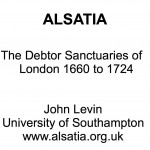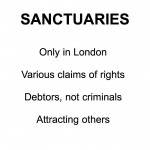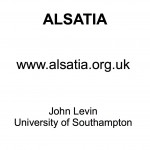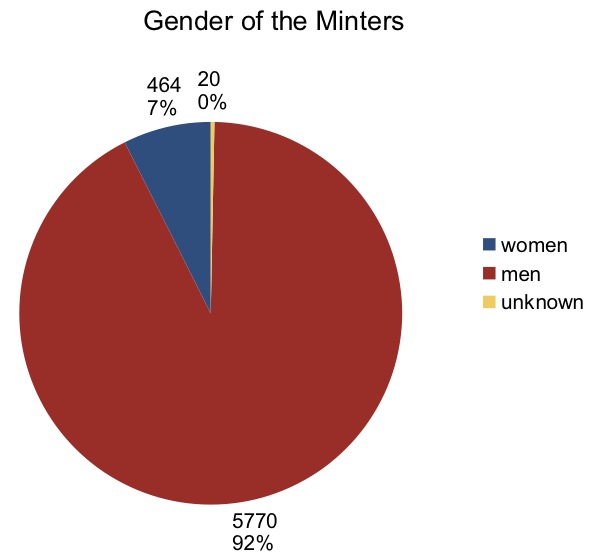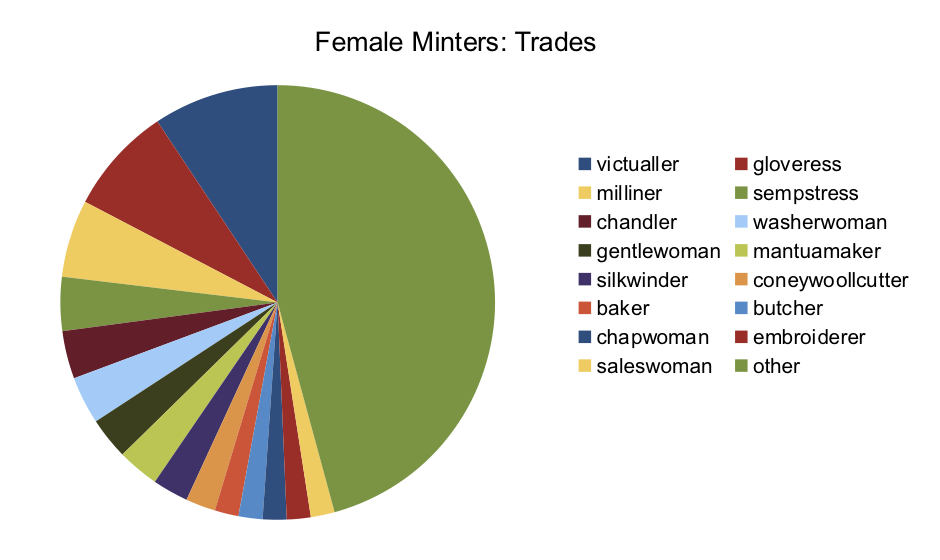Notice: I’ve now taken up the task of scanning these volumes, proofing the OCR and organizing the statutes. Watch http://statutes.org.uk/ for progress.
The law is an important historical source, and especially so for the history of debt. Over the 200 years from Restoration to the abolition of incarceration for insolvency in 1868, there was a constant flow of acts directed at debtors, whether as defaulters, frauds, prisoners, fugitives, pitiable creatures or “evil-disposed and wicked persons.” Hundreds of acts were passed, releasing prisoners, offering amnesties to fugitives, establishing ‘Courts of Conscience’ and regulating debtor prisons. I have transcribed and published some of these statutes, and more will follow. (I’ve re-organized the site to make them easier to find: check the Statutes page for links to the various acts).
These laws have posed two problems: firstly in finding them, and then in understanding their tortuous prose. For the first, quite simply there is no free and complete repository of the legislation. The Official Home of U.K. Legislation has none of the material I require. Much as I appreciate what the National Archive has achieved – and it is a great deal – their remit has been to put current legislation online, not the historic. So although they have published everything in force from 1988 onwards, the vast majority of historic, meaning repealed, legislation is not available. The various proprietary legal databases have either been beyond my reach and pocket, or provide little more than the digital scans available elsewhere.
Which means to find old laws one has to turn to the magnificent libraries and awful metadata of Google Books and Internet Archive. There one can find many different collections of the statutes, albeit of varying quality and completeness, and in the usual disorder that results from mass, indiscriminate digitization.
These digital copies are images of the original works, pictures of books rather than transcriptions of the text, which mean they may be readable by the human eye, but not by the machine. This brings us to the second problem, of the law’s labyrinthine prose. Part of the very nature of law is that it is constantly rewritten, by parliaments and courts, who go about renewing, repealing, interpreting and clarifying, without any guarantee of consistency. The resulting vast, unwieldy corpus is difficult to navigate, full of linguistic peculiarities, tangled and convoluted. To make ones way through this maze would be far easier if one could use the computer to do some of the heavy lifting: searching, digesting, comparing, cross-referencing and so on.
The nascent field of Computational Legal Studies has produced some interesting digital research into law; for example, the Legal Language Explorer, (now dead, but preserved on archive.org) producing ngrams from U.S. Supreme Court decisions, and the attempts to measure the complexity of the U.S. law by Katz and Bommarito (article and slides). If such explorations imply greater spaces to be discovered, and beyond the legal profession, they also show that useful data is an essential prerequisite. In the case of English and British statutes, that requirement is not met by the volumes scanned by Google and the Internet Archive.
It is of course a fundamental right that everyone should have access to the laws governing them; that’s not only the inevitable corollary of the principle ‘ignorance of the law is no excuse’, but also an essential check on state power. This means more than just publishing laws and judgements; they must be published freely, openly, useably and re-usably. A number of organizations are campaigning to open up the law: for example the Free Access to Law Movement, the Law.Gov campaign, and the Open Knowledge Foundation’s legislation working group.
I personally believe that this right to the law should encompass the entirety of the legislation to include the historical, the repealed, for three reasons:
One: Repeal does not mean reversal. Every enclosure bill shows this, for when struck from the book the land did not revert to common ownership. The effects of laws persist beyond their lifetimes.
Two: Repeal does not mean disappearance. The law is historically constituted and continually refers back to itself. Revoked acts and their related judgements remain a part of the legal record.
Three: Repeal does not mean forgetting. We do not live in an eternal present. We have a capacity, a need and a right to memory.
It is in this spirit that I list here all the various freely-available editions of the statutes. They may not be adequate, they may not even be accurate, but it is a gesture towards making this legislation accessible.
The next step will be to transcribe the statutes; a great and arduous task that requires collaboration and infrastructure. Happily, Wikisource have taken the digital copies of Ruffhead’s Statutes At Large, covering 1225 to 1763, and inserted it into their open transcription system. If little of it has actually been transcribed yet, it does at least show the potential for crowdsourcing legal texts, and the usefulness of Wikimedia’s infrastructure for supporting such a project.
Legislation to 1800
There are many collections of statutes; some bibliographic details can be found on Wikipedia. As they have different editorial policies and selection criteria, and as none are fully comprehensive, I’ve listed a number of sets here.
For laws up to 1811, one place to start is with the 4 volumes of The Statutes: Revised Edition from 1870. It is far from complete, as legislation repealed by 1870 is absent, but there is a handy chronological table in each volume to indicate what is present and what is not. The first four volumes of this are online at archive.org, the first three also at Google; I haven’t been able to locate any further, freely available volumes, and I’m not even sure there were any more.
Update 9 May 2015: I have located a handful of volumes beyond the first four, and from the metadata we can see that there were at least 13 volumes.
Volume 1: Henry III to James II: 1235 – 1685: Internet Archive Google
Volume 2: William & Mary to 10 George III: 1688 – 1770: Internet Archive Google
Volume 3: 11 George III to 41 George III: 1770 – 1800: Internet Archive Google
Volume 4: 41 George III to 51 George III: 1801 – 1811: Internet Archive
Volume 7: 2&3 William IV to 6&7 William IV: 1831 – 1836: Internet Archive
Volume 9: 6&7 Victoria to 9&10 Victoria: 1843 – 1846 : Internet Archive
Volume 12: 17&18 Victoria to 19&20 Victoria: 1854 – 1856: Hathi Trust
Volume 13: 20 Victoria to 24&25 Victoria: 1857 – 1861: Hathi Trust
Ruffhead’s series covers 1225 to 1763, the whole run being digitized by the Internet Archive, and is in Wikisource’s transcription system, as described above. In 9 volumes, there is a supplementary volume with a subject index.
Volume 1: 1225 – 1460
Volume 2: 1461 – 1601
Volume 3: 1604 – 1698
Volume 4: 1699 – 1713
Volume 5: 1714 – 1729
Volume 6: 1730 – 1746
Volume 7: 1747 – 1756
Volume 8: 1757 – 1762
Volume 9: 1762 – 1763, Index and Appendix
Complete Index to the Statutes At Large
Perhaps the most often cited collection is that of Danby Pickering. The first 24 volumes were historical, going from 1225 to 1760. After that, it became a contemporary series, publishing the legislation as it was passed. I am deeply indebted to the pseudonymous contributor on the Paradox forums for finding all the google links; I’ve added links to those volumes I’ve found on archive.org.
vol. 1 – 9 Henry III to 14 Edward III (1225-1340); archive.org
vol. 2 – 15 Edward III to 13 Henry IV (1341-1411); archive.org
vol. 3 – 1 Henry V to 23 Edward IV (1412-1482); archive.org
vol. 4 – 1 Richard III to 31 Henry VIII (1484-1539); archive.org
vol. 5 – 32 Henry VIII to 7 Edward VI (1540-1553)
vol. 6 – 1 Mary I – 35 Elizabeth I (1553-1593); archive.org
vol. 7 – 39 Elizabeth to 12 Charles II (1597-1660); archive.org
vol. 8 – 12 Charles II to 1 James II (1661-1685)
vol. 9 – 1 William & Mary to 8 William III (1688-1696); archive.org
vol. 10 – 8 William III to 1 Anne (1696-1701); archive.org
vol. 11 – 2 & 3 Anne to 8 Anne (1703-1708); archive.org
vol. 12 – 8 Anne to 12 Anne (1709-1711); archive.org
vol. 13 – 12 Anne to 5 George I (1713-1717); archive.org
vol. 14 – 5 George I to 9 George I (1718-1721); archive.org
vol. 15 – 9 George I to 2 George II (1722-1728); archive.org
vol. 16 – 2 George II to 9 George II (1729-1735); archive.org
vol. 17 – 9 George II to 15 George II (1736-1741); archive.org
vol. 18 – 15 George II to 20 George II (1742-1746); archive.org
vol. 19 – 20 George II to 22 George II (1747-1749); archive.org
vol. 20 – 23 George II to 26 George II (1750-1752); archive.org
vol. 21 – 26 George II to 30 George II (1753-1756); archive.org
vol. 22 – 30 George II to 32 George II (1757-1759); archive.org
vol. 23 – 33 George II to 1 George III (1760); archive.org
vol. 24 – Index to all Volumes
The continuation of the Pickering series gets rather confusing. Some books appear to be split into parts, others have ‘Part 1’ on the title page but don’t appear to have a sequel. Volume 44 (1802) doesn’t appear to have been digitized. Update 25 November 2015: Volume 44 part 1 can be found through Hathi Trust. Update 28 September 2016: Located the volume on Google Books.
vol. 25 2 George III to 3 George III (1761-1763); archive.org
vol. 26 4 George III to 5 George III (1764-1765); archive.org
vol. 27 6 George III to 7 George III (1765-1766); archive.org
vol. 28 8 George III to 10 George III (1767-1769); archive.org
vol. 29 11 George III to 12 George III (1770-1772); archive.org
vol. 30 13 George III to 14 George III (1773-1774); archive.org
vol. 31 15 George III to 17 George III (1775-1777)
vol. 32 18 George III to 19 George III (1778-1779)
vol. 33 20 George III to 21 George III (1780-1781); archive.org
vol. 34 22 George III to 24 George III (1782-1784)
vol. 35 25 George III to 26 George III (1785-1786)
vol. 36 27 George III to 29 George III (1787-1789)
vol. 37 30 George III to 32 George III (1790-1792)
vol. 38 General Index from 1 George III to 32 George III; archive.org
vol. 39 Pt. 1: 33 George III to 34 George III (1793-1794)
vol. 39 Pt. 2: 34 George III (1794); archive.org
vol. 40 35 George III to 36 George III (1795); archive.org
vol. 41 37 George III to 38 George III (1796-1797); archive.org
vol. 42 Pt. 1: 39 George III (1798-1799); archive.org
vol. 42 Pt. 2: 39 Geo III (Local & Personal) (1800)
vol. 43 41 George III (1801); archive.org
vol. 44 Pt. 1: 43 George III (1802-1803); Hathi Trust
vol. 45 44 George III (1803-1804); archive.org
vol. 46 46 George III (1806)
Nineteenth Century Legislation
Although my main focus is on the seventeenth and eighteenth centuries, I’ve also needed to find various nineteenth century laws. The following list is incomplete, composed of at least two different series, mainly found in the Internet Archive, but with some from Google. Links to years and volumes I’ve missed will be very much appreciated; please leave them in the comments.
1807 47 Geo 3
1808 48 Geo 3
1809 49 Geo 3
1810 50 Geo 3
1811 51 Geo 3
1812 52 Geo 3
1813 53 Geo 3
1814 54 Geo 3
1815 55 Geo 3
1816 56 Geo 3
1817 57 Geo 3
1818 58 Geo 3
1819 59 Geo 3
1820 60 Geo 3 & 1 Geo 4
1821 1 & 2 Geo 4
1822 3 Geo 4
1823 4 Geo 4
1824 5 Geo 4
1825 6 Geo 4
1826 7 Geo 4
1827 7 & 8 Geo 4
1828 9 Geo 4
1829 10 Geo 4
1830 11 Geo 4 / 1 Will 4
1831 1 Will 4
1832 2 & 3 Will 4
1833 3 & 4 Will 4
1834 4 & 5 Will 4
1835 5 & 6 Will 4
1836 6 & 7 Will 4
1837 7 Will 4 / 1 Vic
1837-8 1 & 2 Vic
1839 2 & 3 Vic
1840 3 & 4 Vic
1841 4 & 5 Vic
1842 5 & 6 Vic
1843 6 & 7 Vic
1844 7 & 8 Vic
1845 8 & 9 Vic
1846 9 & 10 Vic
1847 10 & 11 Vic
1847-8 11 Vic / 11 & 12 Vic
1849 12 & 13 Vic
1850 13 & 14 Vic
1851 14 & 15 Vic & on Google
1852 15 & 16 Vic
1853 16 & 17 Vic
1854 17 & 18 Vic
1854-5 18 & 19 Vic
1855-6 19 & 20 Vic
1857 20 Vic
1858 21 & 22 Vic
1859 22 Vic
1860 22 & 23 Vic
1861 24 & 25 Vic
1862 25 & 26 Vic
1863 26 & 27 Vic
1864 27 & 28 Vic
1865 28 & 29 Vic
1866 29 & 30 Vic
1867 30 Vic / 30 & 31 Vic
1867-8 31 & 32 Vic
1869 32 & 33 Vic Another ed.
1870 33 & 34 Vic
1871 34 & 35 Vic
1872 35 & 36 Vic
1873 36 & 37 Vic
1874 37 & 38 Vic
1875 38 & 39 Vic
1877 40 & 41 Vic
1881 44 & 45 Vic
1882 45 & 46 Vic
1884 48 & 49 Vic
1892 55 & 56 Vic
1896 59 & 60 Vic
1902 2 Edw 7
1904 4 Edw 7
1906 6 Edw 7
Update 6/5/2014
I have found some more volumes from the early nineteenth century, many of which I have added to the list above. I’ve also found that there were two related series – the Statutes at Large of England and Great Britain, and The Statutes at Large of Great Britain and Ireland – published at that time, edited first by Tomlins and then Raithby, and then Simons. The former goes up to 1800, and so there’s considerable overlap with all the other editions listed above. Raithby also produced a three volume index, covering the period from the Magna Carta to 49 George III.
Raithby, Statutes At Large of England and Great Britain, in 20 volumes.
Volume 2: 1 Richard II 1377 to 19 Henry VII 1504: Archive Google
Volume 3: 1 Henry VIII 1509 to 7 Edward VI 1553: Archive Google
Volume 4: 1 Mary 1553 to 16 Charles I 1604: Archive Google
Volume 6: 8 William III to 6 Anne 1707: Google
Volume 7: 7 Anne 1708 to 1 George I 1715: Google
Volume 8: 3 George I 1716 to 13 George I 1726: Google
Volume 9: 1 George II 1727 to 15 George II 1742: Google
Volume 10: 16 George II 1743 to 23 George II 1750: Google
Volume 12: 1 George III 1760 to 7 George III 1767: Google
Volume 13: 8 George III 1768 to 14 George III 1774: Google
Volume 14: 15 George III 1775 to 19 George III 1779: Google
Volume 15: 20 George III 1780 to 24 George III 1784: Google
Volume 17: 28 George III 1788 to 32 George III 1792: Google
Volume 18: 33 George III 1793 to 35 George III 1795: Google
Volume 20: 39 George III 1798 to 41 George III 1800: Google
Raithby’s Statutes of the United Kingdom of Great Britain and Ireland:
Updates 28/8/2016 and 11/10/2016: A set of these volumes, annoyingly without volume 10, has been uploaded to the Internet Archive by the University of Southampton. But hallelujah, the elusive Volume the Tenth has been located on Google, as has the 14th through to the 18th, which appears to be the last of this series. Note that later volumes are edited by one N. Simons, rather than Raithby.
Volume 1: 41 George III 1801 to 43 George III 1803: Google Archive.org
Volume 2: 44 George II 1804 to 46 George II 1806: Archive.org
Volume 3: 47 George III 1807 to 49 George III 1809: Google Archive.org
Volume 4: 50 George III 1810 to 52 George III 1812: Google Archive.org
Volume 5: 53 George III to 54 George III 1814: Google Archive.org
Volume 6: 55 George III 1815 to 56 George III 1816: Google Archive.org
Volume 7: 57 George III 1817 to 59 George III 1819: Archive.org
Volume 8: 60 George III 1820 to 3 George IV 1822: Archive.org
Volume 9: 4 George IV 1823 to 5 George IV 1824: Google Archive.org
Volume 10: 6 George IV 1825 to 7 George IV 1826: Google
Volume 11: 7 & 8 George IV 1827 to 10 George IV 1829: Google Archive.org
Volume 12: 11 George IV 1829 to 2 & 3 William IV 1832: Google Archive.org
Volume 13: 3 & 4 William IV 1833 to 5 & 6 Willian IV 1835: Archive.org
Volume 14: 6 & 7 William IV 1836 to 1 & 2 Victoria 1838: Google
Volume 15: 2 & 3 Victoria 1839 to 5 Victoria 1841: Google
Volume 16: 5 & 6 Victoria 1842 to 6 & 7 Victoria 1843. Pt 1: Google Pt 2: Google
Volume 17: 7 & 8 Victoria 1844 to 8 & 9 Victoria 1845. Pt 1: Google Pt 2: Google
Volume 18: 9 & 10 Victoria 1846 to 10 & 11 Victoria 1847: Google
Raithby’s An index to the statutes at large: from Magna Carta, to the forty ninth year of George III inclusive:
Volume 1: Abatement to Inrolment. Google
Volume 2: Insane Persons to Roly Poly. Google
Volume 3: Roman Catholics to Zouch (Souche) and Seymour (Lord). Google
Other Sources
British History Online has two sets of legislation, available under somewhat restrictive terms of use: the complete Acts and Ordinances of the Interregnum, from 1642 to 1660, and volumes 5, 6 and 7 (out of 11) of Raithby’s Statutes of the Realm, covering 1628 to 1701. Various copies of the Interregnum collection are available, readable but not downloadable without a partner account, at Hathi Trust; the final volume, containing the introduction, chronology and index, is freely available at archive.org. Similarly, Hathi Trust has a complete set of Statutes of the Realm available for reading online, but downloadable only by a select few.
Update 28/8/2016: The University of Southampton has uploaded some volumes of Raithby’s Statutes to the Internet Archive.
The National Archives’ offical government repository site, as mentioned above, has all legislation from 1988 onwards, and some historic material. For laws before the Magna Carta, there is the Early English Laws project, although I’m not sure whether it is still active.
As mentioned above, Wikipedia have a great many useful entries describing, listing and classifying the laws and their attendant structure. The best entry page for these, containing links to lists of statutes by parliament and period, is the List of Acts of Parliament in the United Kingdom.
Acknowledgements: Big tip of the hat to Andrew Gray of Wikipedia for introducing me to the crowd-sourced transcription on WikiSource, and for other wikipedia help. Likewise to the pseudonymous Abdul Goatherd, who did most of the legwork gathering Google’s Danby Pickering editions, and published it on this old forum.


